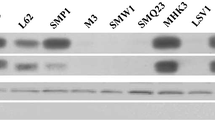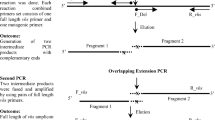Abstract
Vibrio alginolyticus has brought about severe economic damage to the mariculture industry by causing vibriosis in various fish species in South China. The virulent determinants of this bacterium have not been well characterized except the exotoxin alkaline serine protease, Asp. In addition, the mechanism of virulence regulation in V. alginolyticus remains largely unknown apart from a Vibrio harveyi-like quorum sensing (QS) system which is established to manipulate the expression of various virulence-related genes. Hfq, an sRNA chaperone, is an important post-transcriptional regulator in a variety of bacteria. Here, the roles of Hfq were characterized in regulating the stress resistance and pathogenesis in V. alginolyticus. We demonstrated that the hfq deletion mutant became more sensitive to several environmental stresses, including osmotic stress, ethanol, temperature shift, and iron starvation. The deletion of hfq abrogated the motility and biofilm formation in this bacterium. Hfq negatively regulated the expression of main virulence factor, Asp, through QS system. The results also indicated that Hfq modulated the survival and multiplication of V. alginolyticus in fish. Hfq thus appears to be a new pleiotropic regulator of pathogenesis in V. alginolyticus. Moreover, high immunoprotective rate was achieved with a single dose of injection or immersion vaccination with live hfq mutant, suggesting the mutant’s merits as a valuable vaccine candidate against V. alginolyticus.







Similar content being viewed by others
References
Bohn C, Rigoulay C, Bouloc P (2007) No detectable effect of RNA-binding protein Hfq absence in Staphylococcus aureus. BMC Microbiol 7:10
Cao XD, Wang QY, Liu Q, Liu H, He HH, Zhang YX (2010) Vibrio alginolyticus MviN is a LuxO-regulated protein and affects cytotoxicity toward EPC cell. J Microbiol Biotechnol 20:271–280
Chao Y, Vogel J (2010) The role of Hfq in bacterial pathogens. Curr Opin Microbiol 13:24–33
Cheng S, Hu Y, Zhang M, Sun L (2010) Analysis of the vaccine potential of a natural avirulent Edwardsiella tarda isolate. Vaccine 28:2716–2721
Christiansen JK, Larsen MH, Ingmer H, Sogaard-Andersen L, Kallipolitis BH (2004) The RNA-binding protein Hfq of Listeria monocytogenes: role in stress tolerance and virulence. J Bacteriol 186:3355–3362
Costerton JW, Stewart PS, Greenberg EP (1999) Bacterial biofilms: a common cause of persistent infections. Science 284:1318–1322
Denkin SM, Nelson DR (1999) Induction of protease activity in Vibrio anguillarum by gastrointestinal mucus. Appl Environ Microbiol 65:3555–3560
Dennis JJ, Zylstra GJ (1998) Plasposons: modular self-cloning minitransposon derivatives for rapid genetic analysis of gram-negative bacterial genomes. Appl Environ Microbiol 64:2710–2715
Ding Y, Davis B, Waldor M (2004) Hfq is essential for Vibrio cholerae virulence and downregulates σE expression. Mol Microbiol 53:345–354
Enos-Berlage JL, Guvener ZT, Keenan CE, McCarter LL (2005) Genetic determinants of biofilm development of opaque and translucent Vibrio parahaemolyticus. Mol Microbiol 55:1160–1182
Fantappie L, Metruccio MME, Seib KL (2009) The RNA chaperone Hfq is involved in stress response and virulence in Neisseria meningitidis and is a pleiotropic regulator of protein expression. Infect Immun 77:1842–1853
Franze de Fernandez MT, Eoyang L, August JT (1968) Factor fraction required for the synthesis of bacteriophage Qbeta-RNA. Nature 219:588–590
Hammer BK, Bassler BL (2007) Regulatory small RNAs circumvent the conventional quorum sensing pathway in pandemic Vibrio cholerae. Proc Nat Acad Sci USA 104:11145–11149
Josenhans C, Suerbaum S (2002) The role of motility as a virulence factor in bacteria. Int J Med Microbiol 291:605–614
Kulesus RR, Diaz-Perez K, Slechta ES, Eto DS, Mulvey MA (2008) Impact of the RNA chaperone Hfq on the fitness and virulence potential of uropathogenic Escherichia coli. Infec Immun 76:3019–3026
Lee KK, Yu SR, Liu PC (1997) Alkaline serine protease is an exotoxin of Vibrio alginolyticus in kuruma prawn, Penaeus japonicus. Cur Microbiol 34:110–117
Liang WL, Wang SX, Yu FG, Zhang LJ, Qi GM, Liu YQ, Gao SY, Kan B (2003) Construction and evaluation of a safe, live, oral Vibrio cholerae vaccine candidate, IEM108. Infec Immun 71:5498–5504
Link TM, Valentin-Hansen P, Brennan RG (2009) Structure of Escherichia coli Hfq bound to polyriboadenylate RNA. Proc Nat Acad Sci USA 106:19292–19297
Liu CH, Cheng W, Hsu JP, Chen JC (2004) Vibrio alginolyticus infection in the white shrimp Litopenaeus vannamei confirmed by polymerase chain reaction and 16S rDNA sequencing. Dis Aqua Organ 61:169–174
Livak KJ, Schmittgen TD (2001) Analysis of relative gene expression data using real-time quantitative PCR and the 2-ΔΔCT method. Methods 25:402–408
Ma Q, Zhang Y (2007) Characterization of the Vibrio alginolyticus fur gene and localization of essential amino acid sites in fur by site-directed mutagenesis. J Mol Microbiol Biotechnol 13:15–21
Maharjan R, Zhou Z, Ren Y, Li Y, Gaffe J, Schneider D, McKenzie C, Reeves PR, Ferenci T, Wang L (2010) Genomic identification of a novel mutation in hfq that provides multiple benefits in evolving glucose-limited populations of Escherichia coli. J Bacteriol 192:4517–4521
Meibom KL, Forslund AL, Kuoppa K, Alkhuder K, Dubail I, Dupuis M, Forsberg A, Charbit A (2009) Hfq, a novel pleiotropic regulator of virulence-associated genes in Francisella tularensis. Infect Immun 77:1866–1880
Milton DL, O’Toole R, Horstedt P, Wolf-Watz H (1996) Flagellin A is essential for the virulence of Vibrio anguillarum. J Bacteriol 178:1310–1319
Morales VM, Bäckman A, Bagdasarian M (1991) A series of wide-host-range low-copy-number vectors that allow direct screening for recombinants. Gene 97:39–47
Muffler A, Fischer D, Hengge-Aronis R (1996) The RNA-binding protein HF-I, known as a host factor for phage Qbeta RNA replication, is essential for rpoS translation in Escherichia coli. Genes Dev 10:1143–1151
Nakano M, Takahashi A, Su Z, Harada N, Mawatari K, Nakaya Y (2008) Hfq regulates the expression of the thermostable direct hemolysin gene in Vibrio parahaemolyticus. BMC Microbiol 8:155
O’Toole GA, Kolter R (1998) Flagellar and twitching motility are necessary for Pseudomonas aeruginosa biofilm development. Mol Microbiol 30:295–304
Reed LJ, Muench H (1938) A simple method of estimating fifty per cent endpoints. Am J Epidemiology 27:493–497
Rui HP, Liu Q, Ma Y, Wang QY, Zhang YX (2008) Roles of LuxR in regulating extracellular alkaline serine protease A, extracellular polysaccharide and mobility of Vibrio alginolyticus. FEMS Microbiol Lett 285:155–162
Rui HP, Liu Q, Wang QY, Ma Y, Liu H, Shi CB, Zhang YX (2009) Role of alkaline serine protease, Asp, in Vibrio alginolyticus virulence and regulation of its expression by LuxO-LuxR regulatory System. J Microbiol Biotechnol 19:431–438
Sittka A, Pfeiffer V, Tedin K, Vogel J (2007) The RNA chaperone Hfq is essential for the virulence of Salmonella typhimurium. Mol Microbiol 63:193–217
Sonnleitner E, Schuster M, Sorger-Domenigg T, Greenberg EP, Bläsi U (2006) Hfq-dependent alterations of the transcriptome profile and effects on quorum sensing in Pseudomonas aeruginosa. Mol Microbiol 59:1542–1558
Soper T, Mandin P, Majdalani N, Gottesman S, Woodson SA (2010) Positive regulation by small RNAs and the role of Hfq. Proc Nat Acad Sci USA 107:9602–9607
Sousa SA, Ramos CG, Moreira LM, Leitao JH (2010) The hfq gene is required for stress resistance and full virulence of Burkholderia cepacia to the nematode Caenorhabditis elegans. Microbiology 156:896–908
Stepanovi S, Vukovi D, Daki I, Savi B (2000) A modified microtiter-plate test for quantification of staphylococcal biofilm formation. J Microbiol Methods 40:175–179
Thompson KM, Rhodius VA, Gottesman S (2007) σE regulates and is regulated by a small RNA in Escherichia coli. J Bacteriol 189:4243–4256
Tian Y, Wang QY, Liu Q, Ma Y, Cao XD, Guan LY, Zhang YX (2008a) Involvement of LuxS in the regulation of motility and flagella biogenesis in Vibrio alginolyticus. Biosci Biotechnol Biochem 72:1063–1071
Tian Y, Wang QY, Liu Q, Ma Y, Cao XD, Zhang YX (2008b) Role of RpoS in stress survival, synthesis of extracellular autoinducer 2, and virulence in Vibrio alginolyticus. Arch Microbiol 190:585–594
Torres-Quesada O, Oruezabal RI, Peregrina A, Jofré E, Lloret J, Rivilla R, Toro N, Jiménez-Zurdo JI (2010) The Sinorhizobium meliloti RNA chaperone Hfq influences central carbon metabolism and the symbiotic interaction with alfalfa. BMC Microbiol 10:71
Tsui HCT, Leung HCE, Winkler ME (1994) Characterization of broadly pleiotropic phenotypes caused by an hfq insertion mutation in Escherichia coli K-12. Mol Microbiol 13:35–49
Wang QY, Liu Q, Ma Y, Rui HP, Zhang YX (2007) LuxO controls extracellular protease, haemolytic activities and siderophore production in fish pathogen Vibrio alginolyticus. J Appl Microbiology 103:1525–1534
Weber B, Croxatto A, Chen C, Milton DL (2008) RpoS induces expression of the Vibrio anguillarum quorum-sensing regulator VanT. Microbiology 154:767–780
Yang Z, Liu Q, Wang QY, Zhang YX (2008) Novel bacterial surface display systems based on outer membrane anchoring elements from the marine bacterium Vibrio anguillarum. Appl Environ Microbiol 74:4359–4365
Ye J, Ma Y, Liu Q, Zhao DL, Wang QY, Zhang YX (2008) Regulation of Vibrio alginolyticus virulence by the LuxS quorum-sensing system. J Fish Dis 31:161–169
Zhu J, Mekalanos JJ (2003) Quorum sensing-dependent biofilms enhance colonization in Vibrio cholerae. Dev Cell 5:647–656
Acknowledgements
This study was supported by National Natural Science Foundation of China (Nos. 30901113 and U0633004) and Shanghai Leading Academic Discipline Project (No. B505).
Author information
Authors and Affiliations
Corresponding authors
Rights and permissions
About this article
Cite this article
Liu, H., Wang, Q., Liu, Q. et al. Roles of Hfq in the stress adaptation and virulence in fish pathogen Vibrio alginolyticus and its potential application as a target for live attenuated vaccine. Appl Microbiol Biotechnol 91, 353–364 (2011). https://doi.org/10.1007/s00253-011-3286-3
Received:
Revised:
Accepted:
Published:
Issue Date:
DOI: https://doi.org/10.1007/s00253-011-3286-3




